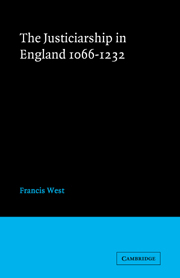Book contents
- Frontmatter
- Contents
- List of Abbreviations
- Introduction
- I THE ORIGINS OF THE JUSTICIARSHIP
- II THE JUSTICIARSHIP UNDER HENRY II
- III THE JUSTICIARSHIP UNDER RICHARD I
- IV THE JUSTICIARSHIP UNDER JOHN: BEFORE THE LOSS OF NORMANDY
- V THE JUSTICIARSHIP UNDER JOHN: AFTER THE LOSS OF NORMANDY
- VI THE JUSTICIARSHIP IN JOHN'S LAST YEARS
- VII THE JUSTICIARSHIP UNDER HENRY III
- Bibliography
- Index
II - THE JUSTICIARSHIP UNDER HENRY II
Published online by Cambridge University Press: 08 January 2010
- Frontmatter
- Contents
- List of Abbreviations
- Introduction
- I THE ORIGINS OF THE JUSTICIARSHIP
- II THE JUSTICIARSHIP UNDER HENRY II
- III THE JUSTICIARSHIP UNDER RICHARD I
- IV THE JUSTICIARSHIP UNDER JOHN: BEFORE THE LOSS OF NORMANDY
- V THE JUSTICIARSHIP UNDER JOHN: AFTER THE LOSS OF NORMANDY
- VI THE JUSTICIARSHIP IN JOHN'S LAST YEARS
- VII THE JUSTICIARSHIP UNDER HENRY III
- Bibliography
- Index
Summary
Henry II, upon his succession to the Crown, was faced with all of the problems with which his predecessor had grappled. Since his empire was so much larger than the original Anglo-Norman dominion his absences were likely to be longer and more frequent and the need for a viceroy correspondingly greater. Because of the anarchy, he had to re-establish royal authority and restore royal resources, which meant employing efficient administrative machinery. And he must do both of these things in circumstances in which loyalties had been strained by the civil war and baronial independence asserted; he needed to re-establish that co-operation between king and baronage upon which society rested. There was an urgent need for the delegation of royal power, but the circumstances were not favourable to the creation of the justiciarship. The new king had to rely upon ministers who, with the exception of Bishop Nigel of Ely, had served Stephen. So far as they were professional royal servants their loyalty could perhaps be taken for granted, since their careers were bound up with the prestige and development of royal power and government, but, so far as they were feudal magnates as well, relations of confidence and trust between them and the king were plainly of gradual growth. Henry's action in applying to Archbishop Theobald for his chancellor is scarcely the action of a man who had a wide choice open to him. Hence the delegation of royal authority was, as it had been in earlier reigns, diffused, and for his regent the king turned, as his predecessor had, to members of his own family.
- Type
- Chapter
- Information
- Justiceship England 1066–1232 , pp. 31 - 63Publisher: Cambridge University PressPrint publication year: 1966



